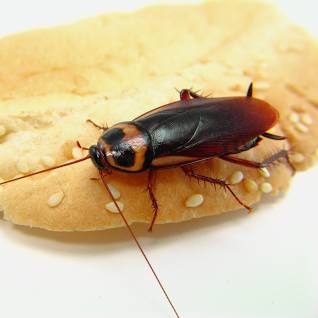Palmetto Roach: Rid Yourself!

# What is the Palmetto cockroach?
The Palmetto cockroach, also known as the American cockroach or the waterbug, is one of the largest and most common species of cockroaches in the world. It can grow up to 1.6 inches in length and has a reddish-brown color with a yellowish margin on the pronotum (the area behind the head). The Palmetto cockroach is an omnivorous scavenger that feeds on a variety of organic materials, including decaying plants, fruits, garbage, and even other insects. It can also survive for long periods without food or water.
# Appearance
The Palmetto cockroach has a flat, oval-shaped body with six long legs and two long antennae. The male has a pair of wings that cover most of its abdomen, while the female has shorter wings that expose the last few segments of her abdomen. Both sexes can fly, but they prefer to run when disturbed. The Palmetto cockroach has a distinctive odor that it produces from glands on its abdomen. This odor is used to communicate with other cockroaches and to deter predators.
# Behavior
The Palmetto cockroach is a nocturnal insect that hides during the day in dark, moist, and warm places, such as sewers, basements, crawl spaces, attics, and under appliances. It can also be found outdoors in mulch, leaf litter, wood piles, and palm trees. The Palmetto cockroach is very adaptable and can tolerate a wide range of temperatures and humidity levels. It can also survive exposure to radiation and some insecticides. The Palmetto cockroach is a social insect that lives in large groups and follows chemical trails left by other cockroaches to find food and shelter.
# Diet
The Palmetto cockroach is an opportunistic feeder that will eat almost anything that is edible, including plant matter, animal matter, starches, sugars, fats, and proteins. It prefers sweet and fermented foods, such as fruits, syrups, beer, and bread. It can also feed on paper, leather, hair, nails, and glue. The Palmetto cockroach can digest cellulose, which is a component of plant cell walls. This gives it an advantage over other insects that cannot break down this substance.
# Habitat
The Palmetto cockroach is native to Africa and was introduced to North America by European settlers in the 1600s. It has since spread to other parts of the world through human activity and commerce. The Palmetto cockroach can be found in urban and suburban areas, as well as rural and natural environments. It prefers warm and humid climates, but can survive in colder regions as well. The Palmetto cockroach can infest any structure that provides food, water, shelter, and access points.
# Reproduction
The Palmetto cockroach reproduces sexually by mating. The female produces an egg case called an ootheca that contains about 16 eggs. She carries the ootheca for a few days before depositing it in a hidden location. The eggs hatch in 6 to 8 weeks and the nymphs emerge. The nymphs are smaller versions of the adults and go through 10 to 13 molts before reaching maturity. The development time from egg to adult varies from 5 to 15 months depending on the environmental conditions. The adult lifespan ranges from 9 to 18 months.
# Prevention tips
The best way to prevent a Palmetto cockroach infestation is to eliminate their food sources, water sources, hiding places, and entry points. Some tips are:
– Store food in sealed containers and clean up spills and crumbs promptly.
– Fix leaky pipes and faucets and eliminate standing water.
– Seal cracks and gaps in walls, floors, doors, windows, and pipes.
– Remove clutter and debris from indoors and outdoors.
– Ventilate moist areas such as bathrooms and kitchens.
– Use screens on doors and windows and install door sweeps.
– Trim vegetation away from the building and remove dead leaves and branches.
– Dispose of garbage regularly and use tight-fitting lids on trash cans.
– Use baits, traps, or insecticides to kill existing cockroaches or hire a professional exterminator.
– Use natural pest control methods such as diatomaceous earth, boric acid, or essential oils to repel or kill cockroaches.